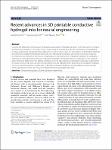Thông tin tài liệu
Thông tin siêu dữ liệu biểu ghi
| Trường DC | Giá trị | Ngôn ngữ |
|---|---|---|
| dc.contributor.author | Kim, Sung Dong | - |
| dc.contributor.author | Kim, Kyoungryong | - |
| dc.contributor.author | Shin, Mikyung | - |
| dc.date.accessioned | 2023-09-15T03:04:53Z | - |
| dc.date.available | 2023-09-15T03:04:53Z | - |
| dc.date.issued | 2023 | - |
| dc.identifier.uri | https://link.springer.com/article/10.1186/s40580-023-00389-z | - |
| dc.identifier.uri | https://dlib.phenikaa-uni.edu.vn/handle/PNK/9033 | - |
| dc.description | CC-BY | vi |
| dc.description.abstract | Recently, the 3D printing of conductive hydrogels has undergone remarkable advances in the fabrication of complex and functional structures. In the field of neural engineering, an increasing number of reports have been published on tissue engineering and bioelectronic approaches over the last few years. The convergence of 3D printing methods and electrically conducting hydrogels may create new clinical and therapeutic possibilities for precision regenerative medicine and implants. In this review, we summarize (i) advancements in preparation strategies for conductive materials, (ii) various printing techniques enabling the fabrication of electroconductive hydrogels, (iii) the required physicochemical properties of the printed constructs, (iv) their applications in bioelectronics and tissue regeneration for neural engineering, and (v) unconventional approaches and outlooks for the 3D printing of conductive hydrogels. | vi |
| dc.language.iso | en | vi |
| dc.publisher | Springer | vi |
| dc.subject | hydrogel inks | vi |
| dc.title | Recent advances in 3D printable conductive hydrogel inks for neural engineering | vi |
| dc.type | Book | vi |
| Bộ sưu tập | ||
| OER - Khoa học Vật liệu, Ứng dụng | ||
Danh sách tệp tin đính kèm:

